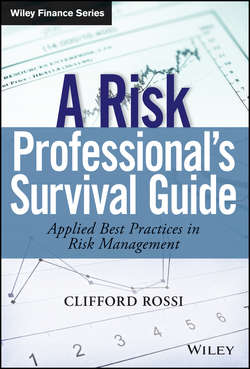Читать книгу A Risk Professional's Survival Guide - Rossi Clifford - Страница 13
На сайте Литреса книга снята с продажи.
CHAPTER 1
Navigating Risk at SifiBank
SUMMARY
ОглавлениеSifiBank’s fortunes have ebbed and flowed over time with different management, regulatory, market and economic conditions. The financial crisis of 2008 exposed deficiencies in risk management governance and infrastructure that nearly led to its demise. The company enjoys a second chance at remaking itself into a world class institution known for its risk management expertise by virtue of a government bailout. The bank still faces a dizzying array of financial and regulatory challenges in the post-crisis environment.
Most notably, the regulatory environment is taking a heavy toll on the bank’s ability to increase operating revenues while managing expenses. Fees associated with various bank services and products such as debit cards and consumer loans have dampened important income sources for SifiBank. This has incented the bank to look for other products that boost profitability without running afoul of regulatory requirements. Mortgages that lie just outside the CFPB Qualified Mortgage criteria could provide the bank with better spreads than conventional mortgages while exposing the firm to minimal legal risk in the future. However, a product development and design framework that vets the collection of bank risks against each other in a way that meets the bank’s objectives would offer the most effective protection. This is where strong risk management practices can make the difference between a sustainable business model and one that experiences a major risk event that puts the entire firm at jeopardy.
Financial risk management is not an exact science despite a revolution over the past two decades to leverage quantitative approaches in measuring and managing risks. A key to successful risk management is knowing the right combination of qualitative controls and quantitative tools to use. The remainder of this book introduces the reader to a complement of key risks faced by SifiBank. While individual risks are examined within specific operating units of SifiBank, it should be understood that these risks span most divisions with variations in exposures based upon the nature of the transactions, and services in place, among other considerations. Further, while most chapters that follow focus on a particular type of risk, as discussed earlier, SifiBank’s risk managers must think about risk holistically. Even within an operating unit such as the mortgage group, business risk managers must evaluate tradeoffs between the credit exposure of putting a mortgage on the balance sheet and the interest rate risk exposure and operational risk it creates. Moreover, potential reputation, regulatory and legal risks must be factored in before implementing a product strategy. Some of these risks do not lend themselves to quantification but still expose the firm to lost business, regulatory actions and penalties, and large legal tabs if not carefully accounted for in product development.
